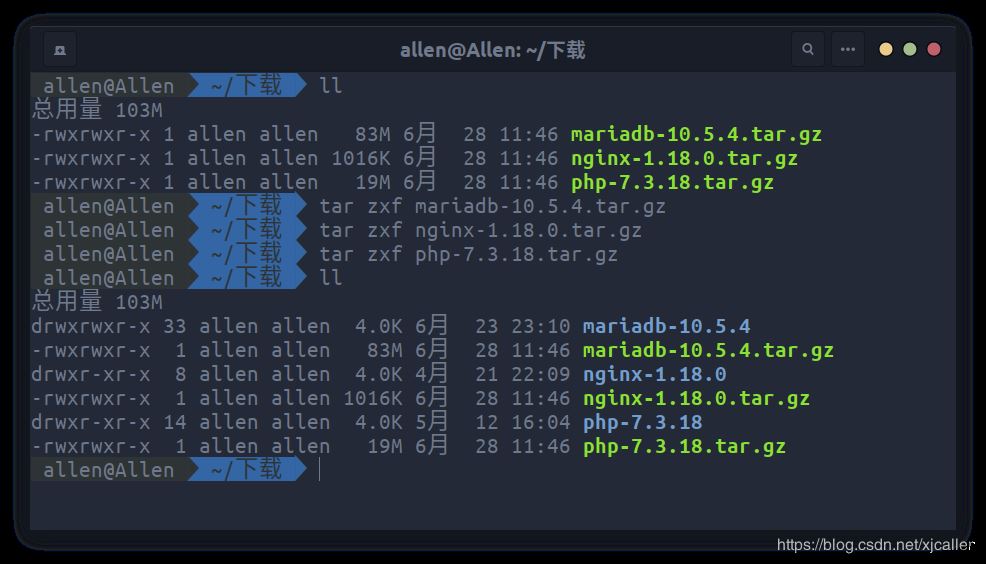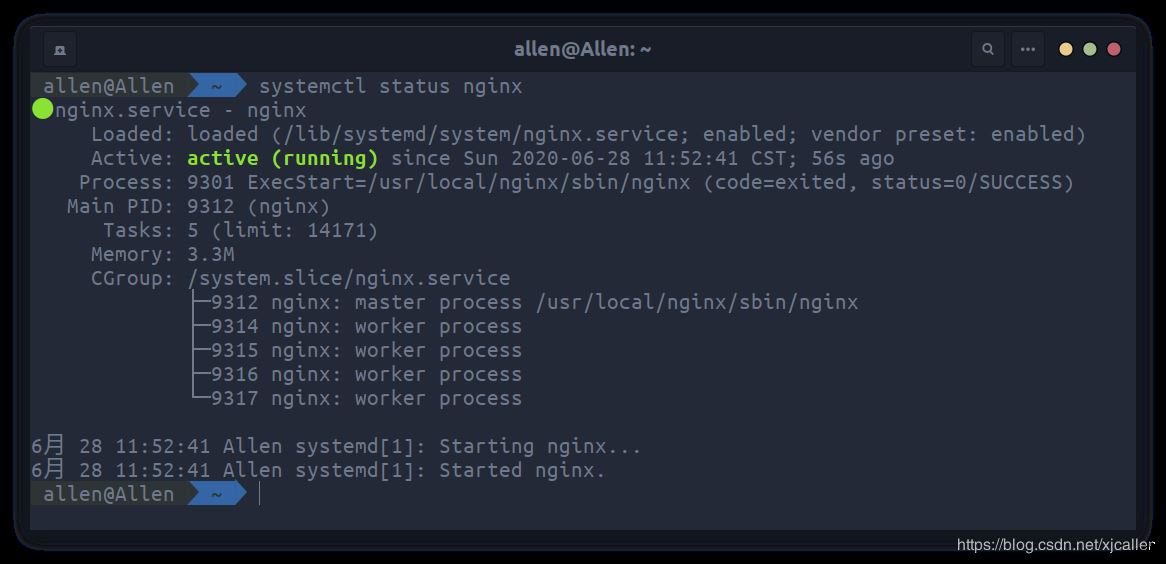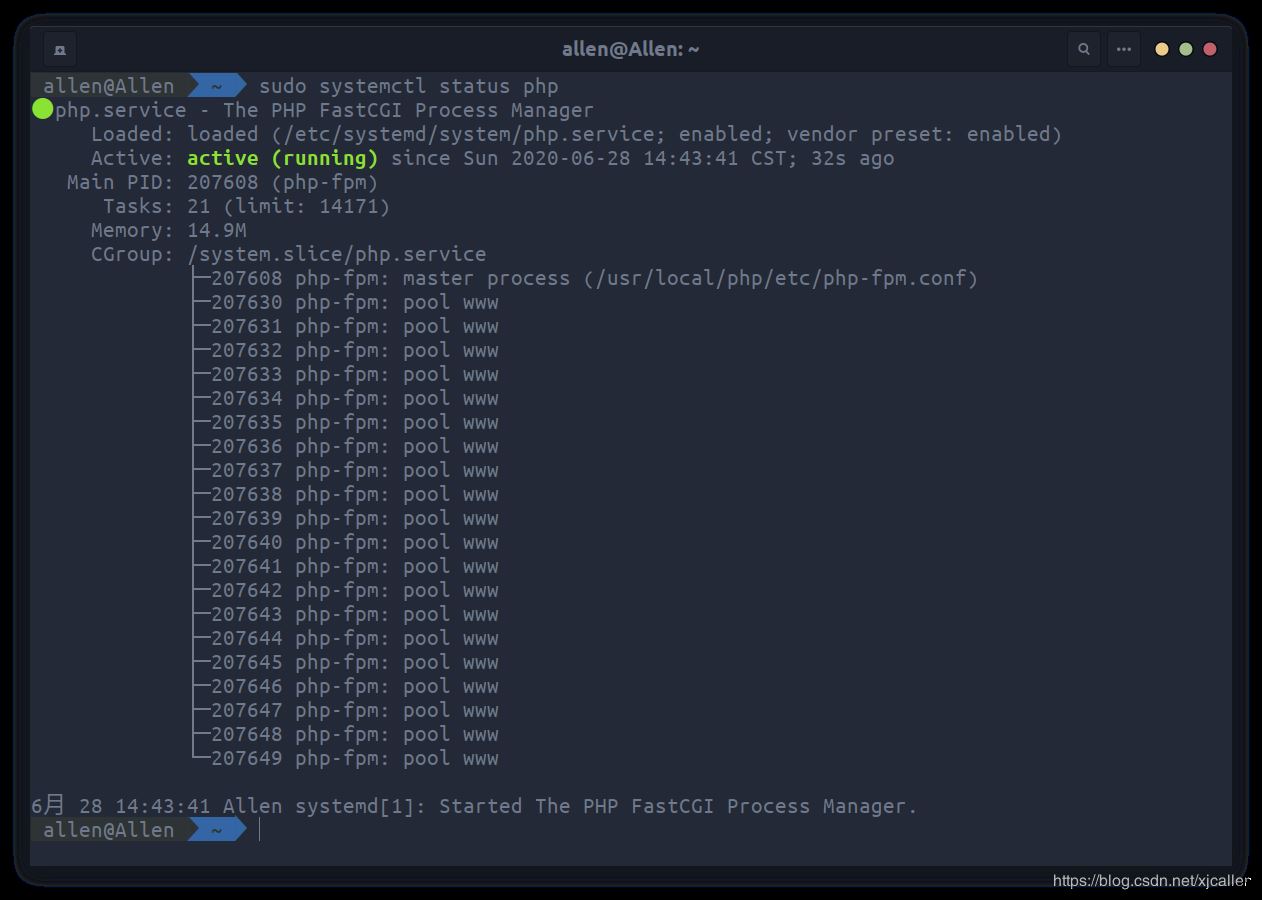- ubuntu12.04环境下使用kvm ioctl接口实现最简单的虚拟机
- Ubuntu 通过无线网络安装Ubuntu Server启动系统后连接无线网络的方法
- 在Ubuntu上搭建网桥的方法
- ubuntu 虚拟机上网方式及相关配置详解
CFSDN坚持开源创造价值,我们致力于搭建一个资源共享平台,让每一个IT人在这里找到属于你的精彩世界.
这篇CFSDN的博客文章ubuntu 20.04上搭建LNMP环境的方法步骤由作者收集整理,如果你对这篇文章有兴趣,记得点赞哟.
简单说明 。
由于之前是用Centos7搭建的,后来使用ubuntu 20.04的系统做为个人开发环境,所以想在ubuntu上也搭建一下环境,和Centos有一些小区别所以记录一下仅供学习.
安装前准备 。
下载软件: php:7.3.18 nginx:1.18.0 mariadb:10.5.4 。
解压文件:
|
1
2
3
|
tar
zxf php-7.3.18.
tar
.gz
tar
zxf mariadb-10.5.4.
tar
.gz
tar
zxf nginx-1.18.0.
tar
.gz
|

安装Nginx 。
|
1
2
3
4
5
6
7
8
9
10
11
12
13
14
15
16
17
18
19
20
21
22
23
24
25
26
27
28
29
30
31
32
33
34
35
36
37
38
39
40
41
42
43
44
45
46
47
48
49
|
sudo
groupadd -r nginx &&
sudo
useradd
-r -g nginx -s
/sbin/nologin
-d
/usr/local/nginx
nginx
sudo
apt
install
-y libpcre3-dev zlib1g-dev
cd
/home/allen/
下载
/nginx-1
.18.0
.
/configure
--user=nginx --group=nginx
make
-j 4 &&
sudo
make
install
sudo
/usr/local/nginx/sbin/nginx
-t
#nginx: the configuration file /usr/local/nginx/conf/nginx.conf syntax is ok
#nginx: configuration file /usr/local/nginx/conf/nginx.conf test is successful
sudo
mv
/usr/local/nginx/conf/nginx
.conf
/usr/local/nginx/conf/nginx
.conf.back
sudo
vim
/usr/local/nginx/conf/nginx
.conf
user nginx;
worker_processes 4;
events {
worker_connections 1024;
}
http {
include mime.types;
default_type application
/octet-stream
;
sendfile on;
keepalive_timeout 65;
log_format main
'$remote_addr || $remote_user || $time_local || $request || $status || $body_bytes_sent || $http_referer || $http_user_agent || $http_x_forwarded_for'
;
include
/data/www/
*/*.conf;
}
sudo
chown
-R nginx:nginx
/usr/local/nginx
sudo
vim
/lib/systemd/system/nginx
.service
[Unit]
Description=nginx
After=network.target
[Service]
Type=forking
ExecStart=
/usr/local/nginx/sbin/nginx
ExecReload=
/usr/local/nginx/sbin/nginx
-s reload
ExecStop=
/usr/local/nginx/sbin/nginx
-s quit
PrivateTmp=
true
[Install]
WantedBy=multi-user.target
sudo
systemctl
enable
nginx
#Created symlink /etc/systemd/system/multi-user.target.wants/nginx.service → /lib/systemd/system/nginx.service.
reboot
|
重启后看看有没有启动成功 。

安装Mariadb 。
|
1
2
3
4
5
6
7
8
9
10
11
12
13
14
15
16
17
18
19
20
21
22
23
24
25
26
27
28
29
30
31
32
33
34
35
36
37
38
39
40
41
42
43
44
45
46
47
48
49
50
51
52
53
54
55
56
57
58
59
60
61
62
63
64
65
66
67
68
69
70
71
72
73
74
75
76
77
78
79
80
81
82
83
84
85
86
87
88
89
90
91
92
93
94
95
96
97
98
99
100
101
102
103
104
105
106
107
108
109
110
111
112
113
114
115
116
117
118
119
120
|
sudo
rm
-rf
/etc/mysql
sudo
apt remove -y mysql-common
sudo
apt autoremove -y
sudo
apt
install
-y cmake libncurses5-dev libgnutls28-dev
sudo
groupadd -r mysql &&
sudo
useradd
-r -g mysql -s
/sbin/nologin
-d
/usr/local/mariadb
mysql
sudo
mkdir
-p
/data/db
/var/log/mariadb
cd
/home/allen/
下载
/mariadb-10
.5.4/
cmake . -DCMAKE_INSTALL_PREFIX=
/usr/local/mariadb
-DMYSQL_DATADIR=
/data/db
-DSYSCONFDIR=
/etc
-DWITHOUT_TOKUDB=1 -DMYSQL_UNIX_ADDR=
/tmp/mysql
.sock -DDEFAULT_CHARSET=utf8mb4 -DDEFAULT_COLLATION=utf8mb4_general_ci
make
-j 4 &&
sudo
make
install
sudo
/usr/local/mariadb/scripts/mysql_install_db
--user=mysql --datadir=
/data/db
sudo
vim
/etc/my
.cnf
[mysqld]
datadir =
/data/db
socket =
/tmp/mysql
.sock
# 建议禁用符号链接,防止各类安全风险
symbolic-links = 0
collation-server = utf8mb4_general_ci
init-connect =
'SET NAMES utf8mb4'
character-
set
-server = utf8mb4
[mysql]
default-character-
set
= utf8mb4
[client]
port = 3306
socket =
/tmp/mysql
.sock
default-character-
set
= utf8mb4
[mysqld_safe]
log-error =
/var/log/mariadb/mariadb
.log
pid-
file
=
/var/run/mariadb/mariadb
.pid
sudo
cp
/usr/local/mariadb/support-files/mysql
.server
/etc/init
.d
/mariadb
sudo
vim
/etc/profile
.d
/mariadb
.sh
export
PATH=$PATH:
/usr/local/mariadb/bin/
sudo
chmod
0777
/etc/profile
.d
/mariadb
.sh
source
/etc/profile
.d
/mariadb
.sh
sudo
/etc/init
.d
/mariadb
start
#Starting mariadb (via systemctl): mariadb.service.
sudo
/usr/local/mariadb/bin/mysql_secure_installation
#NOTE: RUNNING ALL PARTS OF THIS SCRIPT IS RECOMMENDED FOR ALL MariaDB
# SERVERS IN PRODUCTION USE! PLEASE READ EACH STEP CAREFULLY!
#In order to log into MariaDB to secure it, we'll need the current
#password for the root user. If you've just installed MariaDB, and
#haven't set the root password yet, you should just press enter here.
#Enter current password for root (enter for none):
#OK, successfully used password, moving on...
#Setting the root password or using the unix_socket ensures that nobody
#can log into the MariaDB root user without the proper authorisation.
#You already have your root account protected, so you can safely answer 'n'.
#Switch to unix_socket authentication [Y/n] y
#Enabled successfully!
#Reloading privilege tables..
# ... Success!
#You already have your root account protected, so you can safely answer 'n'.
#Change the root password? [Y/n] y
#New password:
#Re-enter new password:
#Password updated successfully!
#Reloading privilege tables..
# ... Success!
#By default, a MariaDB installation has an anonymous user, allowing anyone
#to log into MariaDB without having to have a user account created for
#them. This is intended only for testing, and to make the installation
#go a bit smoother. You should remove them before moving into a
#production environment.
#Remove anonymous users? [Y/n] y
# ... Success!
#Normally, root should only be allowed to connect from 'localhost'. This
#ensures that someone cannot guess at the root password from the network.
#Disallow root login remotely? [Y/n] n
# ... skipping.
#By default, MariaDB comes with a database named 'test' that anyone can
#access. This is also intended only for testing, and should be removed
#before moving into a production environment.
#Remove test database and access to it? [Y/n] y
# - Dropping test database...
# ... Success!
# - Removing privileges on test database...
# ... Success!
#Reloading the privilege tables will ensure that all changes made so far
#will take effect immediately.
#Reload privilege tables now? [Y/n] y
# ... Success!
#Cleaning up...
#All done! If you've completed all of the above steps, your MariaDB
#installation should now be secure.
#Thanks for using MariaDB!
sudo
systemctl
enable
mariadb
sudo
chown
mysql:mysql -R
/usr/local/mariadb
/data/db
/var/log/mariadb
reboot
|
重启后看看有没有启动成功 。

安装PHP 。
|
1
2
3
4
5
6
7
8
|
sudo
apt
install
-y libxml2-dev libssl-dev libbz2-dev libcurl4-gnutls-dev libjpeg-dev libpng-dev pkg-config libxslt1-dev libzip-dev libfreetype6-dev libfontconfig1-dev autoconf
sudo
groupadd -r php &&
sudo
useradd
-r -g php -s
/sbin/nologin
-d
/usr/local/php
php
sudo
vim
/etc/sudoers
php ALL=(ALL:ALL) ALL
cd
/home/allen/
下载
/php-7
.3.18/
.
/configure
--prefix=
/usr/local/php
\--
exec
-prefix=
/usr/local/php
--with-fpm-user=php --with-fpm-group=php --
enable
-zip --with-curl --with-gettext --with-iconv-
dir
--with-kerberos --with-libdir=lib64 --with-mysqli --with-openssl --with-pdo-mysql --with-pdo-sqlite --with-pear --with-xmlrpc --with-xsl --with-zlib --with-bz2 --with-mhash --
enable
-bcmath --
enable
-inline-optimization --
enable
-mbregex --
enable
-mbstring --
enable
-opcache --
enable
-pcntl --
enable
-shmop --
enable
-soap --
enable
-sockets --
enable
-sysvsem --
enable
-sysvshm --
enable
-xml --
enable
-fpm --with-freetype-
dir
--with-gd --with-libxml-
dir
--with-pcre-regex --
enable
-libxml --
enable
-zip --with-png-
dir
--with-jpeg-
dir
|
有一个错误:
configure: error: freetype-config not found. 。
解决办法: 据说:https://www.doopsky.com/ops/981.html 。
这是由于在 Ubuntu 19.04 中 apt-get 安装的 libfreetype6-dev 版本为 2.9.1-3 http://changelogs.ubuntu.com/changelogs/pool/main/f/freetype/freetype_2.9.1-3/changelog 在 changelog 中写到:
The `freetype-config' script is no longer installed by default (Closes: #871470, #886461). All packages depending on libfreetype6-dev should use pkg-config to find the relevant CFLAGS and libraries. freetype-config 被替代成 pkg-config ,新版本使用 pkg-config 管理 CFLAGS 和 库.
所以解决方法如下: 主要的思路就是用pkg-config代替freetype-config。安装pkg-config,我在上面已经安装了 。
|
1
2
3
4
5
6
7
8
9
|
cat ./configure | grep "freetype-config" -n
34847: if test -f "$i/bin/freetype-config"; then
34849: FREETYPE2_CONFIG="$i/bin/freetype-config"
34855: as_fn_error $? "freetype-config not found." "$LINENO" 5
36568: if test -f "$i/bin/freetype-config"; then
36570: FREETYPE2_CONFIG="$i/bin/freetype-config"
36576: as_fn_error $? "freetype-config not found." "$LINENO" 5
sed -i "s/freetype-config/pkg-config/g" ./configure
|
|
1
2
3
4
5
|
cat ./configure | grep "FREETYPE2_CONFIG --cflags" -n
34858: FREETYPE2_CFLAGS=`$FREETYPE2_CONFIG --cflags`
36579: FREETYPE2_CFLAGS=`$FREETYPE2_CONFIG --cflags`
sed -i "s/FREETYPE2_CONFIG --cflags/FREETYPE2_CONFIG freetype2 --cflags/g" ./configure
|
|
1
2
3
4
5
|
cat ./configure | grep "FREETYPE2_CONFIG --libs" -n
34859: FREETYPE2_LIBS=`$FREETYPE2_CONFIG --libs`
36580: FREETYPE2_LIBS=`$FREETYPE2_CONFIG --libs`
sed -i "s/FREETYPE2_CONFIG --libs/FREETYPE2_CONFIG freetype2 --libs/g" ./configure
|
|
1
2
3
4
5
6
|
cat ./ext/gd/config.m4 | grep "freetype-config" -n
188: if test -f "$i/bin/freetype-config"; then
190: FREETYPE2_CONFIG="$i/bin/freetype-config"
196: AC_MSG_ERROR([freetype-config not found.])
sed -i "s/freetype-config/pkg-config/g" ./ext/gd/config.m4
|
重新编译安装就OK 。
|
1
2
3
4
5
6
7
8
9
10
11
12
13
14
15
16
17
18
19
20
21
22
23
24
25
26
|
Thank you
for
using PHP.
make
-j 4 &&
sudo
make
install
sudo
cp
php.ini-production
/usr/local/php/lib/php
.ini
sudo
cp
/usr/local/php/etc/php-fpm
.conf.default
/usr/local/php/etc/php-fpm
.conf
sudo
cp
/usr/local/php/etc/php-fpm
.d
/www
.conf.default
/usr/local/php/etc/php-fpm
.d
/www
.conf
vim
/usr/local/php/etc/php-fpm
.d
/www
.conf
listen.mode = 0666
pm.max_children = 128
pm.start_servers = 20
pm.min_spare_servers = 5
pm.max_spare_servers = 35
pm.max_requests = 10000
slowlog = log/$pool.log.slow
rlimit_files = 1024
sudo
vim
/etc/profile
.d
/php
.sh
export
PATH=$PATH:
/usr/local/php/bin/
sudo
chmod
0777
/etc/profile
.d
/php
.sh &&
source
/etc/profile
.d
/php
.sh
sudo
cp
sapi
/fpm/php-fpm
.service
/etc/systemd/system/php
.service
|
安装xdebug 。
下载xdebug http://pecl.php.net/get/xdebug-2.9.6.tgz 。
|
1
2
3
4
5
6
|
cd
/home/allen/
下载
tar
zxf xdebug-2.9.6.tgz
cd
xdebug-2.9.6
phpize
.
/configure
--with-php-config=
/usr/local/php/bin/php-config
make
-j 4 &&
sudo
make
install
|
安装Apcu 。
下载Apcu http://pecl.php.net/get/apcu-5.1.18.tgz 。
|
1
2
3
4
5
6
|
cd
/home/allen/
下载
tar
zxf apcu-5.1.18.tgz
cd
apcu-5.1.18
phpize
.
/configure
--with-php-config=
/usr/local/php/bin/php-config
make
-j 4 &&
sudo
make
install
|
编辑PHP.INI 。
|
1
2
3
4
5
6
7
8
9
10
11
12
13
14
15
16
17
18
|
sudo
vim
/usr/local/php/lib/php
.ini
date
.timezone = Asia
/Shanghai
expose_php = off
max_execution_time = 0
memory_limit = 4096M
display_errors = On
cgi.fix_pathinfo=0
extension_dir =
"/usr/local/php/lib/php/extensions/no-debug-non-zts-20180731/"
extension=pgsql
extension=apcu
zend_extension=
/usr/local/php/lib/php/extensions/no-debug-non-zts-20180731/xdebug
.so
[xdebug]
xdebug.var_display_max_children=10240
xdebug.var_display_max_data=20480
xdebug.var_display_max_depth=50
|
启动 。
|
1
2
3
4
5
6
|
sudo
systemctl
enable
php-fpm
sudo
chown
-R mysql:mysql
/usr/local/mariadb
sudo
chown
-R nginx:nginx
/usr/local/nginx
sudo
chown
-R php:php
/usr/local/php
reboot
|

到此这篇关于ubuntu 20.04上搭建LNMP环境的方法步骤的文章就介绍到这了,更多相关ubuntu 20.04搭建LNMP内容请搜索我以前的文章或继续浏览下面的相关文章希望大家以后多多支持我! 。
原文链接:https://blog.csdn.net/xjcallen/article/details/106987381 。
最后此篇关于ubuntu 20.04上搭建LNMP环境的方法步骤的文章就讲到这里了,如果你想了解更多关于ubuntu 20.04上搭建LNMP环境的方法步骤的内容请搜索CFSDN的文章或继续浏览相关文章,希望大家以后支持我的博客! 。
我是在项目中使用 keras 的新手。我一直在我的模型中使用generator。 我真的很困惑我应该输入什么值 1) In fit_generator : steps_per_epoch & vali
假设我们有如下情况: A has to give $10 to B. B has to give $20 to C. C has to give $10 to D. 现在这种情况可以简化为: A lo
我正在尝试对特定列(在工作表“OA”中)进行相对引用,我需要在 110 的步骤中检索新工作表中的单元格内容 例如, =OA!$AB217 =OA!$AB327 =OA!$AB437 与其在每个单元格中
我的 PowerShell 控制台启动时间很慢(总是等待超过 5 秒),并且希望获得有关故障排除步骤的建议,以找出瓶颈可能在哪里? 我已经阅读了关于运行脚本的内容,-NoProfile防止模块等加载很
我在 NativeScript 应用程序中使用 slider 小部件,我想知道是否有步骤属性。在我的例子中,小部件代表金钱,我希望以 5 美元的增量滑动。 我查看了文档,但找不到任何对这种情况有帮助的
我在 NativeScript 应用程序中使用 slider 小部件,我想知道是否有步骤属性。在我的例子中,小部件代表金钱,我希望以 5 美元的增量滑动。 我查看了文档,但找不到任何对这种情况有帮助的
这是我的code : &n
为什么 (2) c.ERR(模棱两可)?第一个方法参数 - char ('a') 被扩展为 float => 匹配。 如果找到匹配项,是否无需继续执行第 2 步(装箱/拆箱)或第 3 步(尝试可变参数
我有一个函数,它处理一个包含 6100 个列表项的列表。当列表只有 300 个项目时,该代码可以正常工作。但是立即与 6100 崩溃。有没有一种方法可以遍历这 6100 个项目,一次说 30 个,然后
1.制作PHP安装程序的原理 其实PHP程序的安装原理无非就是将数据库结构和内容导入到相应的数据库中,从这个过程中重新配置连接数据库的参数和文件,为了保证不被别人恶意使用安装文件,当安装
我创建了一个类似于 primeNG page 的步骤组件我想把他放在一个 dynamic dialog 里面但在应用它之后,“第 1 步”和“第 2 步”不会呈现。 查看代码,我发现关键部分是我们打开
我在理解描述的 MixColumns 步骤时遇到问题 here . 我知道扩散,这一切都是有道理的,因为它指出每列都被视为多项式并乘以 GF(2^8) 的模。 但是..乘以GF(2 ^ 8)。尽管域仍
根据我对 TeamCity 工作原理的观察,我注意到在所有步骤执行完毕后评估构建失败条件。这很烦人,因为如果满足任何构建失败条件,我不能有一个不会执行的步骤。 我不是指常见的构建失败条件,例如“至少一
基于这篇试图在我的环境中测试管道代码的帖子。但它给出了以下错误消息。如何修复他的管道代码? ERROR: Unable to find project for artifact copy: test
我参与了一个项目,需要向我的一位同事提供生产数据的子集(日期范围),以进行故障排除。我想将经过清理的生产数据子集插入新的数据库表中我的同事可以访问。请提出实现此目标的最佳方法。 最佳答案 最简单的方法
我有这样的场景: 鉴于我去这个页面 当我输入 cucumber 时 然后我点击 然后我应该看到文字 我不应该看到这条线 如果我运行这个场景,它将执行所有 5 个步骤。但是我想跳过第4步(然后我应该看到
是否有任何功能可以避免 m 文件的绘图输出? 我的意思是我在文件的开头放置了一个函数(如 clc),然后所有绘图函数都被阻止。 最佳答案 您可以使用自己的(嵌套在您的函数内或同一目录中)重载内置绘图函
我是小 cucumber 语言的新手,这在我看来是非常基本的问题,但我找不到答案。 我知道可以在 Gherking 中编写多行步骤参数,如下所示: Given a blog post named "R
即使其中一个步骤失败,有没有办法继续执行 Cucumber Steps。在我当前的设置中,当一个步骤失败时, cucumber 会跳过剩余的步骤......我想知道是否有某种方法可以设置 cucumb
start-step-stop 码是一种数据压缩技术,用于压缩相对较小的数字。 该代码的工作原理如下:它具有三个参数,start、step 和 stop。 Start 确定用于计算前几个数字的位数。

我是一名优秀的程序员,十分优秀!